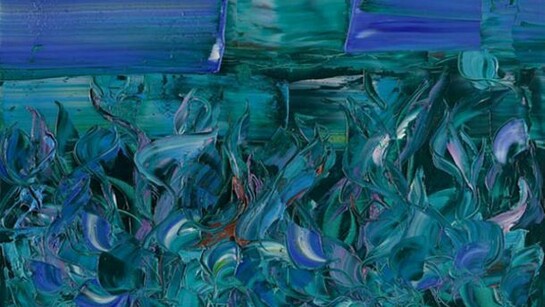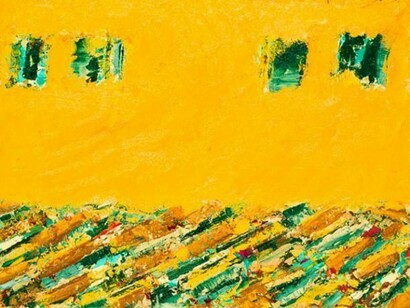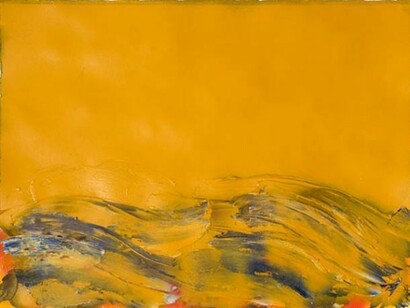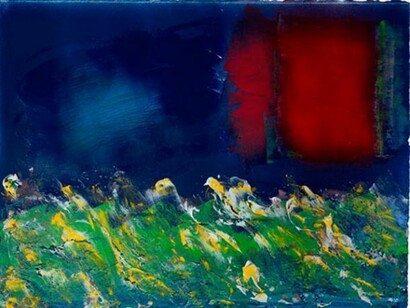Monday 4th November marks the opening, at A.A.M. Architettura Arte Moderna, of Giancarlo Limoni’s “Paesaggi” [Landscapes], an exhibition in two successive parts, both stages of which will fill and redefine the gallery’s spaces with works from the same cycle. The opening of the second part of the exhibition on Monday 9th December will also see the presentation of a monograph dedicated to Giancarlo Limoni and his work of the past fifteen years.
The overall theme of the two exhibitions is that of landscape, a subject central to the artist’s most recent work but also the theme of his more naturalistic paintings ever since the 1980s.
It is significant that after a brief hiatus dedicated to a broad range of different projects connected with art and architecture outside the gallery context, A.A.M. Architettura Arte Moderna now resumes its “normal” activities with an exhibition dedicated to Giancarlo Limoni, the artist with whom we left off, thus underlining an important element of continuity in the gallery’s modus operandi.
Over the course of this articulated exhibition a selection of over forty works will be presented: large oil paintings on canvas, along with over thirty large watercolours and small preparatory sketches, together representing the entire cycle. “Paesaggi” begins, not by chance, with a series of works that present themselves as a “limit”, a “threshold”, in which the artist’s gaze, looking down from overhead, transforms “Nel blu il paesaggio” or “Sentinelle” into veritable overtures, in which the painting becomes increasingly rarefied thanks to a process of subtraction, a removal of colour and material that has characterised Limoni’s more recent work. The frontality and the bird’s eye view of these pieces paved the way for the prolific “A perdita d’occhio” series, with paintings such as “Paesaggio con terra rossa” (2010) or “Paesaggio Viola” (2011) which, with their theme of the “fragmentation” and “mineralization” of places and of the land, give a form and substance to the Sturm und Drang of the Turneresque vortices of “Marina Verde” (2009) and “Marina del nord” (2012). It is only after having confronted a diversity of gazes, and having probed the limits of vision itself, that Limoni arrives at the apparent suspension and the tremulous serenity of the peaceful expanses of “Marina con cielo giallo” (2013) and other paintings handling the same theme. But then he seems to have immediately drawn back and almost taken refuge from (even surprised by) his own new-found Democritean “cheerfulness”, and he has put himself on the line yet again, rediscovering the pleasures of that vertiginous instability with which he is most at his ease in “Cieli gialli” and “Cieli rossi” (both 2013) and other paintings like them. And so, with these allusions to a plunging into the depths, Limoni once again takes to the air – with renewed energy and a new impetus and daring – setting off “to rediscover the stars”.
A presage of this U-turn in his work was offered in 2007 in the form of “Paesaggio sommerso” and “Tentativo di paesaggio”, two extraordinary pieces that remained hidden in the “shadows” of the artist’s studio while he concentrated on preparing the cycle “Non ho tempo (Je n’ai pas le temp)” / “Lezione di tenebre: opere dal nero”, presented at A.A.M. Architettura Arte Moderna in the October of 2009. In the two “secret” paintings Limoni has allowed elements of landscape to bloom, above a busy naturalistic buzz of colour that occupies the picture plane, which becomes a veritable stage, the scene it displays a disorderly hedgerow or bank of vegetation, stirred by a sort of “baroque wind”, simultaneously concealing and revealing the horizon beyond. Clearly the two paintings represent the artist’s desire to free himself of the severity of his “opere dal nero” series, and of the constraints involved in making of his work the pure apparition that emerges from the tarry backgrounds which characterized his paintings of that period. It was these elements in particular that suggested the central theme and the core problem addressed in his work for the current exhibition. As we observed and discussed these two paintings with the artist, ideas emerged for our next joint adventure, and the six small “studies” that Limoni produced in 2008 were born: the beginning of a new “story”.
In these sketches, abandoning the sumptuous use of material that has always typified his work, the artist seems to concentrate on a circumscribed focusing on details, on fragments of landscape, on clots of material, amid lava-like explosions, liquid dispersions/dilutions and suddenly-appearing horizons, at first unstable and then increasingly defined.
Working together in this way, the intention has been to celebrate the very particular function played by A.A.M. Architettura Arte Moderna, the gallery’s project-based approach, the maieutic method we apply, working together with the gallery’s artists to analyze and identify possible directions to be taken within the art system as a whole (from Architecture and Design to Contemporary Art and Photography). This modus operandi has undoubtedly become a point of strength and of reference but, importantly, there is no intention or risk here of confusing the true authorship of the work of our always-autonomous individual artists, and still less of presenting ourselves as the ”prompters” of sudden and fortuitous “revelations” on the artists’ road to Damascus.
The story that emerges in the exhibition and the book is, among other things, the story of a close relationship between the artist and A.A.M.. The book summarizes and recounts the cycles of work that Limoni has produced for the four solo exhibitions that A.A.M. has dedicated to him over the course of the years, the aim being to illustrate and analyse the significance of what has been a shared “journey”. As we have already underlined, in portraying this joint adventure there is no intention of representing the gallery’s role as one of “interfering” in the artist’s work – just the reciprocal “solicitations” and “cross references” between the artist and those involved in commissioning works. A journey that has seen us united in a passage from the hints and fragments of the inflamed paintings in which Limoni skilfully blended his early “Scuola Romana” work and the “dilutions” and “expansions” inspired by Emil Nolde, and then, gradually, his discovery of the East, the profound depths and resurfacings in his “opere dal nero” series and his recent arrival on and amid the stark shores and landscapes so redolent of Eliot’s “The Waste Land”. The exhibition and the book also make public, for the first time, Giancarlo Limoni’s private counterpart to all this in the form of his various “traveller’s diaries”, offering a moment of reflection on the delicate passage from details to the universal, from microcosm to macrocosm.
Giancarlo Limoni was one of the protagonists of the Nuova Scuola Romana in the 1980s together with artists like Domenico Bianchi, Bruno Ceccobelli, Gianni Dessì, Giuseppe Gallo, Enrico Luzzi, Nunzio, Claudio Palmieri, Piero Pizzi Cannella, Sergio Ragalzi, and Marco Tirelli, many of whom worked with Fabio Sargentini’s gallery L’Attico. His work featured in many of the decade’s most influential group shows, including "Nuove trame dell'Arte" in Genazzano, "Anni ‘80" in Bologna, "La nuova scuola romana" in Graz, "Trent'anni dell'Attico" in Spoleto, "Capodopera" in Fiesole and "Post-Astrazione" in Milan. In 1986 he moved his studio to the Prenestino district in Rome, and he still lives and works in the city.
Exhibition curated by Francesco Moschini.
A.A.M. Architettura Arte Moderna
Via Dei Banchi Vecchi, 61
Rome 00186 Italy
Ph. +39 06 68307537
info@aamgalleria.it
www.aamgalleria.it
Opening hours
Monday - Friday from 4pm to 8pm
Saturday and Sunday by appointment
Related images
- Giancarlo Limoni, Studio per paesaggio, 2008, olio su tela, 40 x 50 cm, Copyright: Giancarlo Limoni, Courtesy: A.A.M. Architettura Arte Moderna, Roma
- Giancarlo Limoni, Paesaggio su fondo viola, 2011-2012, olio su tela, 203 x 245 cm, Copyright: Giancarlo Limoni, Courtesy: A.A.M. Architettura Arte Moderna, Roma
- Giancarlo Limoni, Paesaggio del sud, 2010, tecnica mista su carta Arches, 56 x 76 cm, Copyright: Giancarlo Limoni, Courtesy: A.A.M. Architettura Arte Moderna, Roma
- Giancarlo Limoni, Il paesaggio diventa cinese, 2012, tecnica mista su carta Arches, 56 x 76 cm, Copyright: Giancarlo Limoni, Courtesy: A.A.M. Architettura Arte Moderna, Roma
- Giancarlo Limoni, Paesaggio, 2011-2012, olio su tela, 195 x 295 cm, Copyright: Giancarlo Limoni, Courtesy: A.A.M. Architettura Arte Moderna, Roma
- Giancarlo Limoni, Apparizioni, 2010, tecnica mista su carta Arches, 56 x 76 cm, Copyright: Giancarlo Limoni, Courtesy: A.A.M. Architettura Arte Moderna, Roma














